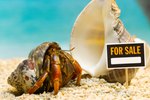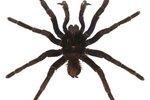Things You'll Need
Large Aquarium (minimum 10 gallons per crab)
Dirt and Aquarium Pebbles
Plants
Water
Blue Crab
Dead Fish or other food
A soft-shell crab is actually just a common blue crab that has recently molted. When eating seafood, typically blue crab is what you would find in diners and turns red when you boil it. Blue crabs are alert animals and will respond to you. During their growth, the blue crab sheds its hard exoskeleton leaving a soft-shelled crab. It is extremely difficult to get the crab at this point because if it is not eaten by others, the hard shell begins to grow back.
Raising a Soft-Shelled Crab
Cover the bottom of the aquarium with dirt and pebbles. It needs to be thick enough for the crab to have room to hide under its surface. It should also be uneven so that when water is added to the tank, the crab can be completely submerged or on dry ground.
Place plants in the dirt giving more areas for the crab to hide. The crab will eat live plants so they will need to be replaced.
Fill part of aquarium with a small amount of slightly salty water giving the crab a swimming area. The water temperature should be kept at 72 degrees F. The pH balance should be between 6 to 8 to maintain life.
Feed the crab dead fish or any other dead seafood, such as shrimp or oysters.
Watch for the crab to shed its outer shell as the shell turns green 14 to 50 days prior to molting. Crabs go through the molting stage several times throughout their lives, but it is during this stage it is considered a soft-shell crab.
Tips
Keep the water clean by circulating it with a pump or changing it frequently. Crab will eat or tear apart anything that is added to the aquarium.
Warnings
If you are raising multiple crabs be prepared for them to eat each other when they do reach the soft-shell stage.
If you add other animals to your aquarium, check with a specialist to make sure it is a breed your crab will not eat, nor one that will eat your crab.
Beware of a crab's pinchers.
References
Photo Credits
-
Jeffrey Hamilton/Lifesize/Getty Images
Writer Bio
Stacy McCullough has an M.F.A. in creative writing and has been an educational, marketing, copy writing, grant and business development freelancer since 2008. She has years of editing and design experience, has taught writing in various communities and has led workshops to train teachers and promote writing in the community.





